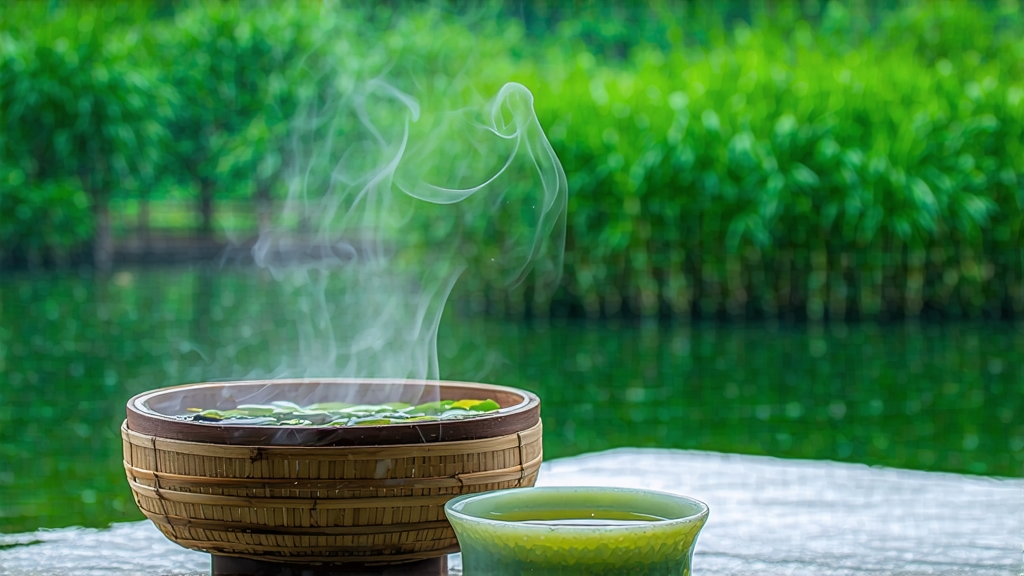
Longjing, literally “Dragon Well,” is more than a tea; it is a liquid manuscript of Chinese civilization. Its story begins in the Tang dynasty (618-907 CE) when the monks of Hangzhou’s forested hills first pressed wild camellia leaves between heated stones to still their green vitality. By the Song era (960-1279) the same leaves were tribute-shipped to the imperial court along the Grand Canal, wrapped in silk and escorted by lantern-bearing guards. The Qianlong Emperor (r. 1735-96) famously fled his traveling caravan during a southern inspection, stole into Lion Peak Mountain disguised as a commoner, and plucked leaves so avidly that he missed the noon prayer bell at Yongfu Temple. He later decreed the eighteen bushes he had touched as “Imperial Trees,” a status they retain today behind a low jade-green fence visited by thousands of pilgrims each April.
Geography is destiny for Longjing. The West Lake basin is a shallow saucer of silica-rich soil ringed by quartzite peaks that fracture morning sunlight into soft, shifting mists. The water itself—fed by subterranean karst springs—maintains a constant 16 °C, cooling the roots in summer and warming them in winter. These microclimates create the tea’s signature “four unique features”: jade color, vegetal aroma, chestnut sweetness, and sword-shaped leaf that stands upright when infused.
Within the protected West Lake appellation, five micro-terroirs are officially honored. Shífeng (Lion Peak) yields the most complex cup, its leaves flecked with pale apricot veins and a whisper of azalea. Méijiāwǔ, a narrow valley once terraced by Ming loyalists, produces a silkier liquor with a trace of steamed bok choy. Wēngjiāshān offers a flinty minerality reminiscent of a Loire sauvignon, while Hǔpáo (Tiger Spring) carries the limestone bite of its namesake pool. Longjing Village itself, now dotted with cafés and calligraphy studios, still delivers the archetype: balanced, bright, and softly toasty.
The plucking calendar is ruthless. Only the first fourteen days after Qingming (early April) are deemed “pre-ming,” when the bud and adjacent single leaf stretch exactly 2.5 cm—shorter, and aromatics are locked; longer, and tannins intrude. Experienced pickers work from 6 a.m. to 10 a.m., before the sun burns off dew and raises leaf temperature above 15 °C. A whispered rule: “No bud in the basket after the cicada sings,” because post-Qingming rain swells cells and dilutes flavor.
Within thirty minutes of plucking, the leaves arrive at the village’s open-air withering court. Here they are spread no thicker than two fingers on bamboo mats, turned every ten minutes by hand to coax out 10 % moisture and grassy volatility. The true soul of Longjing, however, is forged in the pan. A seasoned “tea chef” heats a bare iron wok to 280 °C, rubs it with a tuft of fresh tea oil, then flings in 250 g of leaves. For the next three minutes the movements are fast—grab, press, toss—killing green enzymes while locking in chlorophyll. Temperature drops to 80 °C for the final shaping stage: palms flatten leaves against the wok in a spiral motion, coaxing the iconic sword profile and polishing surface cells to a jade sheen. One mis-timed second scorches the batch; one hesitant touch under-fixes it, inviting sourness later in the cup. Mastery is measured by sound: the leaves must hiss like light rain on a lotus pond, never crackle.
After pan-firing, the tea is “rested” in unglazed earthen jars for seven days, allowing residual moisture to migrate outward. A final charcoal bake at 50 °C for twenty minutes reduces water to 3 %, low enough for year-round stability yet high enough to preserve the living enzymes that will continue aging gracefully for eighteen months.
To brew Longjing is to negotiate between reverence and precision. Begin with spring water whose TDS lies between 30–80 ppm; Shanghai tap at 180 ppm dulls